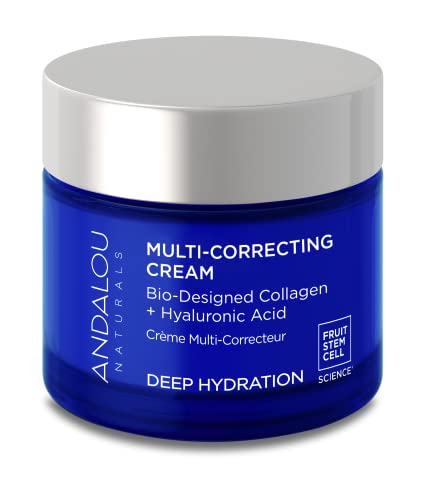
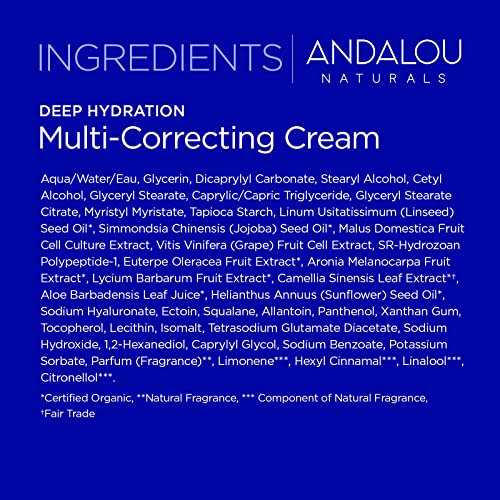
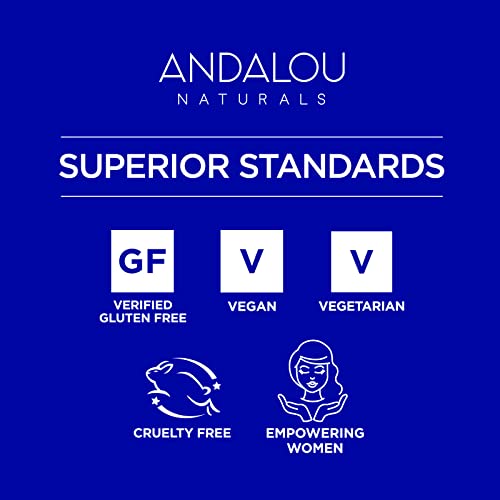
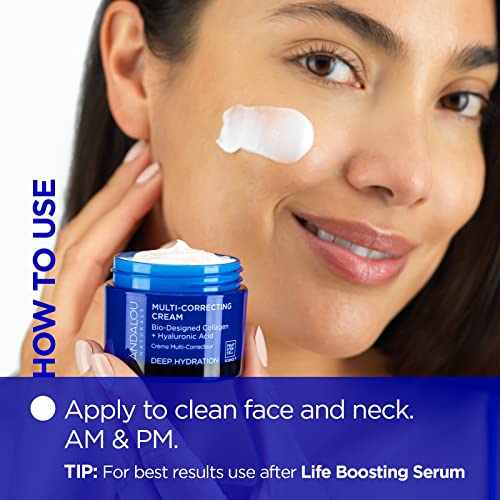
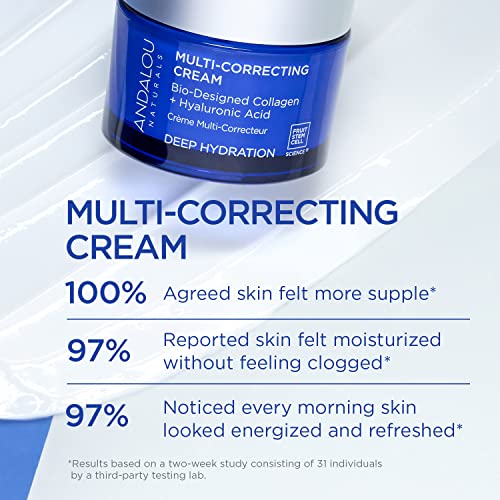
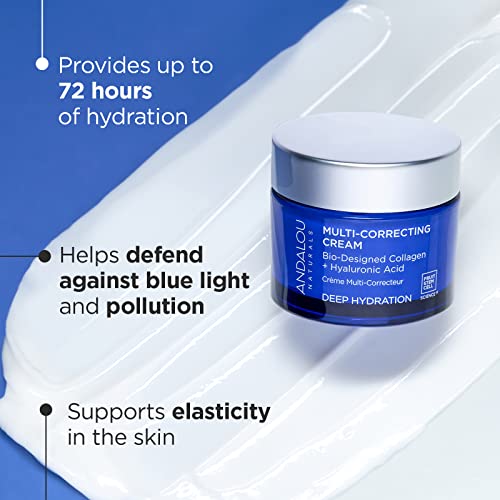
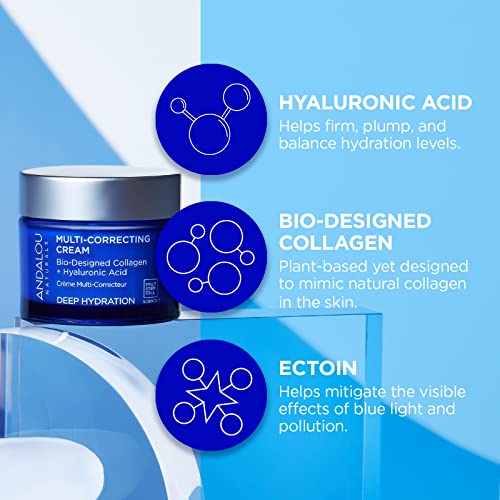
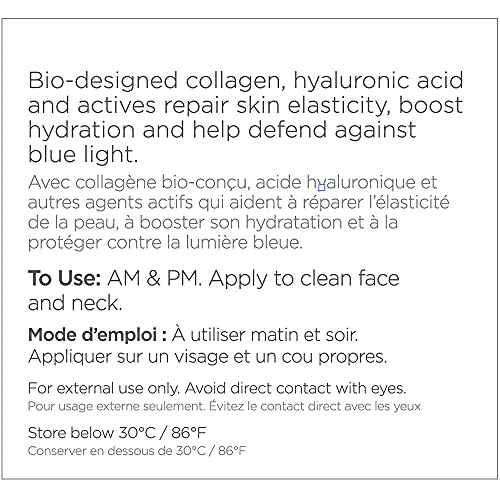
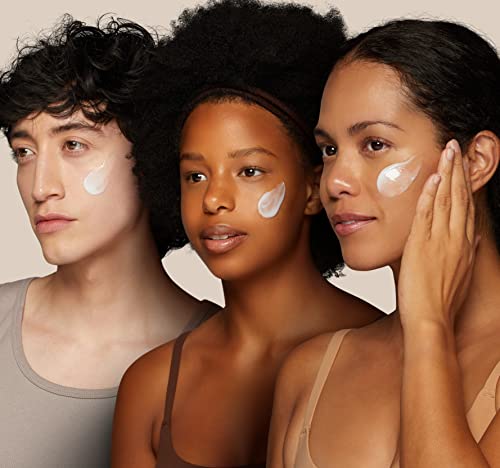
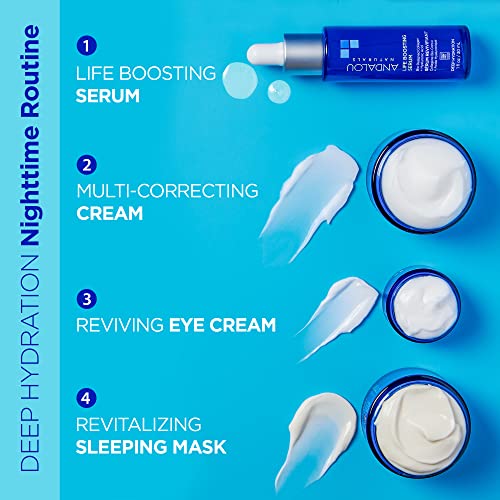
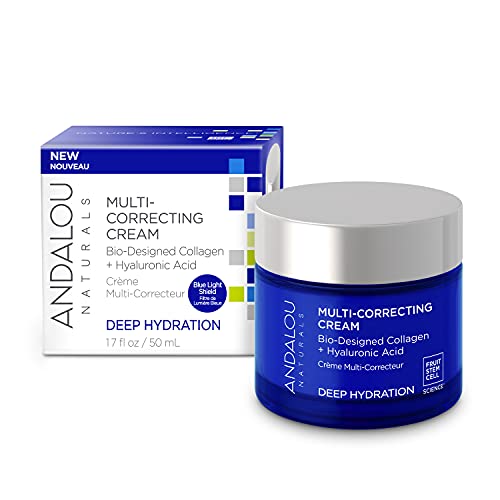
Andalou Naturals Deep Hydration Face Moisturizer - Restores Elasticity & Hydration, 1.7 fl oz


Hexyl Cinnamal
High RiskHexyl cinnamal is a naturally occurring and synthetic fragrance ingredient used primarily for its pleasant floral scent. It is commonly found in personal care and cosmetic products, contributing to their aromatic profiles.
Sustai Insights
Hexyl cinnamal provides a desirable fragrance in cosmetic formulations, enhancing product appeal. However, it is associated with a high allergenic potential, posing risks of skin irritation and sensitization. While it is not classified as a carcinogen or reproductive toxin, its use is restricted in certain regions. Overall, the ingredient presents a high risk due to its allergenic properties, necessitating caution in formulations, especially for sensitive populations.
Citronellol
High RiskCitronellol is a naturally occurring scent ingredient commonly found in various essential oils. It is primarily used for its aromatic properties in perfumes, cosmetics, and household products, contributing to fragrance profiles.
Sustai Insights
Citronellol serves as a fragrance component, enhancing product appeal. However, it has a high allergenic potential, posing risks of skin irritation and sensitization. Environmental concerns include contamination risks. Regulatory bodies have restrictions on its use, emphasizing caution. Overall, citronellol presents a high risk regarding health and safety, warranting careful consideration in product formulations.
Fragrance
High RiskFragrance refers to a mixture of aromatic compounds used in products to provide scent. It is commonly listed as 'fragrance' or 'parfum' on product labels and can serve various functions, including enhancing user experience and masking undesirable odors.
Sustai Insights
Fragrance offers functional benefits by improving product appeal; however, it poses significant health risks, notably a high likelihood of causing allergies and allergic contact dermatitis. Environmental risks include potential pollution and endocrine disruption, though its overall carcinogenicity is low. Regulatory bodies have noted concerns regarding its use, leading to a high-risk classification. Safe usage practices should be observed, and alternatives such as natural essential oils are recommended for those sensitive to synthetic fragrances.
Linalool
High RiskLinalool is a terpene commonly found in various plants, particularly in lavender and mint. It is primarily used in products for its fragrance and potential antimicrobial properties. Linalool is also utilized in formulations for its ability to enhance the sensory experience of personal care and household products.
Sustai Insights
Linalool offers functional benefits as a naturally occurring fragrance component and may exhibit antimicrobial properties. However, it presents high allergenic potential, with concerns about skin irritation and sensitization. Environmental risks include contamination issues, though it is not classified as a persistent pollutant. Regulatory bodies have noted the need for careful handling due to its allergenic nature. Overall, despite some beneficial attributes, the ingredient carries a high risk profile, warranting cautious use and consideration of safer alternatives.
Limonene
Medium RiskLimonene is a scent ingredient and solvent naturally found in citrus fruits, commonly used in personal care and cleaning products for its fragrant properties. It serves as a flavoring agent and enhances the overall sensory experience of products.
Sustai Insights
Limonene offers functional benefits such as acting as a solvent and fragrance enhancer. However, it carries a high allergenic potential, which can trigger skin or respiratory sensitivities in some individuals. Environmental concerns include moderate persistence and bioaccumulation, along with potential ecotoxicity. Regulatory restrictions necessitate verification in products containing this ingredient. Overall, the risk level is assessed as medium, emphasizing the importance of cautious use, particularly for sensitive populations. Safer alternatives may be considered to mitigate these risks.
Potassium Sorbate
Medium RiskPotassium sorbate is a potassium salt of sorbic acid, primarily used as a preservative in food and cosmetic products. It inhibits the growth of molds, yeast, and some bacteria, extending the shelf life of products. It is commonly found in various formulations due to its effectiveness and low toxicity.
Sustai Insights
Potassium sorbate serves as an effective preservative, preventing microbial growth in food and cosmetic products, which is vital for safety and longevity. Although it has a low risk of carcinogenicity and developmental toxicity, there is a moderate concern regarding allergies and immunotoxicity. Environmentally, it poses minimal risks as it is not significantly bioaccumulative. Regulatory agencies have verified its use, although some products may face restrictions. Overall, it is assessed as a medium risk ingredient, with safe usage practices recommended, and alternatives such as natural preservatives could be considered.
Sodium Benzoate
Medium RiskSodium benzoate is a preservative commonly used in food and cosmetic products to prevent microbial growth and extend shelf life. It is derived from benzoic acid and is effective at low concentrations, often used in acidic environments like beverages and condiments.
Sustai Insights
Sodium benzoate serves effectively as a preservative, contributing to product stability and safety. It is generally recognized as safe with low concerns for carcinogenicity, allergies, and reproductive toxicity, though it faces moderate use restrictions in some regions. Environmental risks include its potential as a pollutant, but it does not bioaccumulate significantly. Regulatory bodies have issued advisories regarding its concentration in products. Overall, the risk level is assessed as medium, with safe usage practices recommended. Alternatives such as potassium sorbate may provide similar benefits with potentially lower restrictions.
Lecithin
Medium RiskLecithin is a naturally occurring lipid found in various plant and animal tissues, primarily composed of phospholipids. It serves as an emulsifier, stabilizing mixtures of oil and water, and is commonly used in food, cosmetics, and pharmaceuticals to improve texture and extend shelf life.
Sustai Insights
Lecithin provides functional benefits as an effective emulsifier and stabilizer, enhancing product texture while being sustainably sourced from natural origins. Health risks are generally low, with moderate concerns regarding allergies and immunotoxicity but minimal cancer or reproductive toxicity risks. Environmental hazards are limited, and it is not classified as a pollutant. Regulatory bodies impose few restrictions. Overall, lecithin presents a medium risk, suggesting caution in usage, especially for sensitive individuals. Alternatives include sunflower lecithin or other plant-based emulsifiers that may offer similar benefits with reduced allergenic potential.
Euterpe Oleracea (Acai) Fruit Extract
Low RiskEuterpe oleracea (acai) fruit extract is derived from the acai palm's fruit, primarily used in cosmetic formulations for its antioxidant properties and skin conditioning benefits. It is noted for its rich content of polyphenols and vitamins, contributing to overall product efficacy.
Sustai Insights
Euterpe oleracea extract provides functional benefits, including antioxidant properties that can enhance skin health and support hydration. It is sustainably sourced, contributing to environmentally friendly practices. Health risks are minimal, with low concerns for carcinogenicity, allergies, and reproductive toxicity. Environmental risks are also low, with no significant pollutants or bioaccumulation noted. Regulatory status is favorable, with no major restrictions. Overall, the ingredient is assessed as low risk, with safe usage practices advised for sensitive populations.
Sr Hydrozoan Polypeptide 1
Low RiskSR-Hydrozoan Polypeptide-1 is a single chain recombinant polypeptide derived from hydrozoan organisms. It is primarily used in cosmetic formulations for its potential hydrating and skin-conditioning properties.
Sustai Insights
SR-Hydrozoan Polypeptide-1 offers functional benefits as a skin-conditioning agent, contributing to hydration. It is not associated with significant health risks, with low concerns regarding carcinogenicity, allergies, and reproductive toxicity. Environmentally, it poses low risks without bioaccumulation or pollution potential. The ingredient is not currently restricted by regulatory agencies, indicating a low-risk profile overall. Safe usage practices should be followed, and alternatives may include other skin-conditioning agents that do not compromise efficacy.
Squalane Oil
Low RiskSqualane oil is a lightweight, colorless oil derived from olive or sugarcane that is commonly used in cosmetic formulations. It functions primarily as a moisturizer and emollient, enhancing skin hydration while imparting a silky texture to products. Squalane is also known for its stability and resistance to oxidation, making it a favored ingredient in skincare.
Sustai Insights
Squalane oil is recognized for its effective moisturizing properties and is sustainably sourced, often derived from olives or sugarcane, contributing to its eco-friendly profile. Health risks are minimal, with low concerns for carcinogenicity, allergies, or reproductive toxicity. Environmental impact is also low, as it is not known to bioaccumulate or pollute. Regulatory bodies have not placed restrictions on its use. Overall, the ingredient poses a low risk, making it a safe option in cosmetic products. Alternatives such as jojoba oil or other plant-based emulsifiers may offer similar benefits.
Caprylic Triglyceride
Low RiskCaprylic triglyceride is an ester derived from coconut oil and glycerin, commonly used in cosmetic formulations as an emollient, stabilizer, and skin-conditioning agent. It helps to improve the texture and spreadability of products while providing a lightweight, non-greasy feel.
Sustai Insights
Caprylic triglyceride offers functional benefits such as enhanced skin moisturization and improved formulation stability. It is generally regarded as safe, with low concerns regarding carcinogenicity, allergenic potential, and reproductive toxicity. Environmental impact is minimal, with no significant pollutant or bioaccumulative properties identified. Regulatory bodies have not issued warnings or restrictions. Overall, the risk level is low, making it a suitable ingredient in cosmetic products. Safe usage practices include adhering to recommended concentrations, and while there are alternatives, caprylic triglyceride remains a reliable choice.
Xanthan Gum
Low RiskXanthan gum is a polysaccharide, a sugar-based compound produced by the fermentation of glucose or sucrose. It is commonly used as a thickening agent and stabilizer in various food and cosmetic products due to its ability to improve texture and prevent ingredient separation.
Sustai Insights
Xanthan gum serves effectively as a thickener and stabilizer, enhancing product texture and consistency. It is biodegradable and typically derived from renewable sources, supporting sustainability efforts. Health risks are minimal, with low concerns regarding carcinogenicity, allergies, and reproductive toxicity. Environmental impact is similarly low, posing no significant hazards. Regulatory agencies, including the FDA, regard it as safe for use, with no significant restrictions. Overall, xanthan gum is assessed as low risk, making it a suitable ingredient in formulations.
Stearyl Palmitate
Low RiskStearyl palmitate is an ester derived from stearyl alcohol and palmitic acid, primarily used as an emollient and thickening agent in cosmetic products. It functions to enhance the texture and application of formulations, providing a smooth feel on the skin.
Sustai Insights
Stearyl palmitate serves as an effective emollient, improving product texture and skin feel. It is considered to have low health risks, including irritant potential, and poses minimal environmental concerns, such as pollutant risk. Regulatory bodies have not imposed significant restrictions. Overall, the ingredient is assessed as low risk, with no substantial adverse impacts noted. Alternatives include natural oils or butters that may offer similar benefits.
Sodium Acetylhyaluronate
Low RiskSodium acetylhyaluronate is a sodium salt derivative of hyaluronic acid, commonly used in cosmetic formulations for its hydrating properties. It functions primarily as a humectant, attracting moisture to the skin and helping to maintain hydration levels in various personal care products.
Sustai Insights
Sodium acetylhyaluronate is recognized for its effective moisture-retaining properties, enhancing skin hydration and improving product texture. It has low health risks, with negligible concerns regarding carcinogenicity, allergies, or reproductive toxicity. Environmentally, it poses minimal risks and is not associated with significant pollution or bioaccumulation. Regulatory assessments indicate no current restrictions. Overall, it is considered low risk, making it a favorable ingredient in cosmetic formulations.
Isomalt
Low RiskIsomalt is a mixture of polysaccharides produced from sucrose, primarily used as a sugar substitute in various food and cosmetic products due to its functional properties such as sweetness and stability. It is often valued for its lower caloric content compared to traditional sugars.
Sustai Insights
Isomalt serves effectively as a sweetener and bulking agent, contributing to product texture and flavor without the high caloric content of sugar. It is considered low-risk concerning health effects, with minimal concerns regarding carcinogenicity, allergies, or reproductive toxicity. Environmentally, isomalt is not classified as a significant pollutant and poses low bioaccumulation risk. While regulatory bodies do not impose strict limitations, it is noted that certain formulations should avoid excess isomalt. Overall, isomalt presents a low-risk profile, making it a suitable choice in formulations.
Ectoin
Low RiskEctoin is a heterocyclic compound primarily used in cosmetic and personal care products for its protective properties against environmental stressors. It functions as a moisture regulator and stabilizer, enhancing the skin's resilience to dryness and irritation.
Sustai Insights
Ectoin is recognized for its functional benefits, particularly in protecting skin from dehydration and environmental damage. It is biodegradable and sustainably sourced, contributing positively to environmental credentials. Health risks are minimal, with low concerns for carcinogenicity, allergies, and reproductive toxicity. There are no significant environmental hazards associated with ectoin, and it is not subject to regulatory restrictions. Overall, the ingredient presents a low risk profile, making it a safe choice for use in personal care formulations. Alternatives are limited, but innovations in similar protective agents may offer options.
Cetyl Alcohol
Low RiskCetyl alcohol is a long-chain organic alcohol commonly used in cosmetic formulations. It serves as an emollient, emulsifier, and thickening agent, enhancing the texture and stability of products. Cetyl alcohol is derived from natural sources, such as coconut or palm oil, and is often included in creams, lotions, and hair conditioners.
Sustai Insights
Cetyl alcohol offers functional benefits as an emollient and emulsifier, improving product texture and stability. It is biodegradable and sourced from renewable materials, contributing to sustainability. Health risks are minimal, with low concerns for carcinogenicity, allergies, or reproductive toxicity. Environmental impact is also low, with no significant pollutant or bioaccumulation potential. Regulatory bodies have not placed restrictions on its use, indicating a favorable safety profile. Overall, cetyl alcohol is assessed as low risk, and safe usage practices include ensuring proper formulation concentrations.
Malus Domestica Fruit Cell Culture Extract
Low RiskMalus domestica fruit cell culture extract, derived from apple fruit cell cultures, is primarily used in cosmetic formulations for its hydrating and antioxidant properties. It is incorporated to enhance skin health and improve the stability of products through its natural compounds.
Sustai Insights
Malus domestica fruit cell culture extract offers functional benefits such as hydration and antioxidant support, contributing positively to skin care. It is considered low risk regarding health concerns, including carcinogenicity and allergenic potential, with minimal environmental impact. Regulatory assessments indicate no significant restrictions. Safe usage practices should be followed, with alternatives like other botanical extracts available for similar benefits. Overall, the ingredient is assessed to have a low risk.
Linum Usitatissimum (Linseed) Seed Oil
Low RiskLinum usitatissimum (linseed) seed oil is an oil extracted from the seeds of the flax plant, primarily used for its emollient properties in cosmetic formulations. It is known for its moisturizing and soothing effects on the skin, making it a common ingredient in various personal care products.
Sustai Insights
Linum usitatissimum (linseed) seed oil is recognized for its emollient benefits, providing hydration and skin barrier support. It is sustainably sourced and biodegradable. Health risks are minimal, with low concerns for carcinogenicity, allergies, or reproductive toxicity. Environmental risks are also low, with no significant pollutant or bioaccumulative potential. Regulatory bodies have not issued restrictions. Overall, it presents a low risk, making it a safe choice in formulations. For alternatives, consider other plant-based oils like jojoba or argan oil.
Caprylyl Glycol
Low RiskCaprylyl glycol (1,2-octanediol) is a multifunctional cosmetic ingredient primarily used as a skin-conditioning agent and preservative. It is derived from caprylic acid, a fatty acid found in coconut oil, and is commonly included in personal care products for its moisturizing properties.
Sustai Insights
Caprylyl glycol offers functional benefits such as acting as an effective humectant and preservative, enhancing skin hydration and product stability. It is considered to have low health risks, with no significant concerns regarding carcinogenicity, allergies, or reproductive toxicity. Environmentally, it poses minimal risks, being non-bioaccumulative and not linked to pollution. Regulatory assessments affirm its safety, with no major advisories against its use. Overall, the ingredient is assessed to have a low risk, making it a suitable choice in cosmetic formulations.
Dicapryl Carbonate
Low RiskDicapryl carbonate is an ester derived from caprylic acid and carbonic acid. It is used primarily as an emollient and skin conditioning agent in cosmetic formulations, providing a smooth and soft feel to the skin.
Sustai Insights
Dicapryl carbonate serves as an effective emollient, enhancing the texture of skincare products. It is biodegradable and sustainably sourced, contributing positively to environmental sustainability. Health risks are minimal, with low concerns for cancer, allergies, or reproductive toxicity. There are no significant environmental hazards associated with its use, and it is not subject to regulatory restrictions. Overall, the ingredient presents a low risk profile, making it a favorable choice in cosmetic applications.
Water
Low RiskWater is a clear, colorless liquid essential for various biological processes. It serves as a solvent in formulations, facilitating the dissolution of other ingredients and enhancing product texture and application. Additionally, water plays a crucial role in hydration and is a key component in many cosmetic and personal care products.
Sustai Insights
Water is an effective solvent and hydrator, contributing to the texture and efficacy of formulations. It is biodegradable and generally regarded as safe, with low concerns regarding carcinogenicity, allergies, and reproductive toxicity. However, excessive water usage can lead to environmental concerns, particularly regarding resource depletion. Regulatory bodies do not impose restrictions on water use in cosmetics. Overall, the risks associated with water are low, making it a safe and essential ingredient.
Panthenol, D
Low RiskPanthenol, also known as provitamin B5, is a humectant commonly used in cosmetic and personal care products. It functions primarily as a moisturizer, enhancing skin hydration and improving the appearance of hair by imparting shine and softness.
Sustai Insights
Panthenol is effective in retaining moisture, thus providing functional benefits for skin and hair care products. It is generally recognized as safe, with low concerns regarding carcinogenicity, allergies, and developmental toxicity. However, potential cumulative exposure from multiple sources exists. Environmental risks are minimal, and it is not bioaccumulative. Regulatory bodies have not issued significant warnings; therefore, the overall risk level is assessed as low. For optimal use, it is recommended to follow product guidelines, and alternatives such as glycerin may also be considered for moisturizing effects.
Glyceryl Stearate Citrate
Low RiskGlyceryl stearate citrate is a citric acid ester of glycerol and stearic acid, commonly used as an emulsifier and stabilizer in cosmetic formulations. It helps blend oil and water components, enhancing product texture and consistency.
Sustai Insights
Glyceryl stearate citrate offers functional benefits as an effective emulsifier, improving product stability and texture. It is considered safe, with low concerns for cancer, allergies, and reproductive toxicity. However, it may cause skin irritation in some individuals. Environmental risks are minimal, with no significant bioaccumulation or pollutant potential. Regulatory bodies have not placed significant restrictions on its use. Overall, the ingredient is assessed as low risk, with safe usage practices recommended, and alternatives may include other emulsifiers like cetearyl alcohol.
Allantoin
Low RiskAllantoin is a naturally occurring nitrogenous compound found in various plants and animals. It is commonly used in cosmetic formulations for its soothing and moisturizing properties, as well as its ability to promote skin cell turnover and healing.
Sustai Insights
Allantoin offers functional benefits such as skin soothing, hydration, and promoting cell regeneration. It is generally recognized as safe, with low concerns regarding carcinogenicity, allergies, and reproductive toxicity. Environmentally, it poses minimal risks, being biodegradable and sustainably sourced. Regulatory bodies do not impose significant restrictions on its use. Overall, the risk level associated with allantoin is low, making it a favorable ingredient in personal care products.
Vitis Vinifera (Grape)
Low RiskVitis vinifera (grape) is a plant material derived from grape seeds and skins, commonly used in cosmetic formulations for its antioxidant properties. It serves various functions, including as a moisturizer and skin-conditioning agent, contributing to the overall efficacy of personal care products.
Sustai Insights
Vitis vinifera (grape) offers functional benefits such as providing hydration and antioxidant effects, which can enhance skin health. It is sustainably sourced and generally regarded as safe with low concerns regarding carcinogenicity, allergies, and reproductive toxicity. However, minimal regulatory restrictions exist, and no significant environmental hazards are noted. Overall, the ingredient is considered low risk, making it a suitable option in cosmetic formulations without notable adverse health effects or environmental impact.
Tocopherol, D Alpha
Low RiskTocopherol, specifically d-alpha tocopherol, is a naturally occurring form of Vitamin E. It is commonly used in cosmetic and personal care products primarily for its antioxidant properties, helping to protect formulations from oxidation and extend shelf life.
Sustai Insights
D-alpha tocopherol provides effective antioxidant benefits, contributing to product stability. It is sustainably sourced and generally regarded as safe, with low concerns regarding carcinogenicity, allergies, and reproductive toxicity. However, there are minor concerns about endocrine disruption. Regulatory bodies have not imposed significant restrictions, indicating low overall risk. Recommended usage practices include adhering to established safe concentration thresholds. Alternatives, such as other forms of Vitamin E or plant-based antioxidants, may also be considered.
Vegetarian Glycerin
Low RiskVegetarian glycerin, also known as glycerol, is a colorless, odorless, and viscous liquid derived from plant sources. It is primarily used as a humectant, solvent, and emollient in various personal care products, helping to retain moisture and improve texture.
Sustai Insights
Vegetarian glycerin offers functional benefits as an effective humectant, promoting hydration and skin smoothness. It is biodegradable and typically sustainably sourced. Health risks associated with glycerin are low, with no significant concerns for carcinogenicity, allergens, or reproductive toxicity. Environmental risks are minimal, and it is not subject to major regulatory warnings. Overall, the risk level for this ingredient is low, making it a safe choice in formulations. Safe usage practices include ensuring proper concentrations in products, and alternatives such as propylene glycol exist but may have differing properties.
Simmondsia Chinensis (Jojoba)
Low RiskSimmondsia chinensis, commonly known as jojoba, is an oil derived from the seeds of the jojoba plant. It is commonly used in cosmetic formulations for its moisturizing properties, acting as an emollient and skin conditioning agent.
Sustai Insights
Jojoba oil offers functional benefits such as effective skin moisturization and is biodegradable, with sustainable sourcing practices. Health risks are low, with minimal concerns regarding carcinogenicity, allergies, and reproductive toxicity. Environmental impact is negligible, with no pollutant or bioaccumulation potential. Regulatory status is favorable with no significant restrictions noted. Overall, it is assessed as low risk, and safe usage practices should be maintained. Alternatives include other plant-derived oils like argan or almond oil, which may provide similar benefits.
Tapioca Starch
Low RiskTapioca starch is a carbohydrate extracted from the cassava root, primarily used as a thickening agent in food products and as a binding agent in various formulations. It is known for its ability to provide a smooth texture and enhance the consistency of products.
Sustai Insights
Tapioca starch offers functional benefits such as serving as an effective thickener and stabilizer in food and cosmetic formulations. It is derived from a renewable source and is biodegradable, contributing to sustainability. Health risks are minimal, with low concerns regarding carcinogenicity, allergenic potential, and reproductive toxicity. Environmental risks are also low, with no significant pollutants or bioaccumulation identified. Regulatory bodies, including the FDA, have approved its use without significant restrictions. Overall, tapioca starch presents a low risk profile, making it a safe ingredient in various applications.
Helianthus Annuus (Sunflower) Seed
Low RiskHelianthus annuus (sunflower) seed is derived from the seeds of the sunflower plant and is commonly used in various cosmetic and personal care products. It serves primarily as an emollient and skin conditioning agent, providing moisture and enhancing the texture of formulations.
Sustai Insights
Helianthus annuus (sunflower) seed offers functional benefits, including skin conditioning and moisturizing properties, while being sustainably sourced and biodegradable. Health risks are minimal, with low concerns for carcinogenicity, allergies, and reproductive toxicity. Environmentally, it presents low risks of pollution or bioaccumulation. Regulatory assessments indicate no current restrictions. Overall, it is considered a low-risk ingredient, and safe usage practices should be maintained. Alternative ingredients may include other plant-based oils, but the sunflower seed oil remains a viable option.
Stearyl Alcohol
Low RiskStearyl alcohol is a compound produced from the hydrogenation of stearic acid, commonly used in cosmetic formulations as an emulsifier and thickening agent. It helps stabilize products by blending oil and water phases, enhancing texture and consistency.
Sustai Insights
Stearyl alcohol provides functional benefits as an emulsifier and stabilizer, contributing to improved product texture. It is generally regarded as safe with low concerns for cancer, allergies, and reproductive toxicity. However, it may cause moderate skin, eye, or respiratory irritation. Regulatory bodies do not impose significant restrictions, indicating a low overall risk. While it poses minimal health and environmental hazards, caution is advised for sensitive individuals. Alternatives like cetyl alcohol or plant-based emulsifiers may offer safer options for formulators.
Euterpe Oleracea (Acai) Fruit Extract
Low RiskEuterpe oleracea (acai) fruit extract is derived from the acai palm's fruit, primarily used in cosmetic formulations for its antioxidant properties and skin conditioning benefits. It is noted for its rich content of polyphenols and vitamins, contributing to overall product efficacy.
Sustai Insights
Euterpe oleracea extract provides functional benefits, including antioxidant properties that can enhance skin health and support hydration. It is sustainably sourced, contributing to environmentally friendly practices. Health risks are minimal, with low concerns for carcinogenicity, allergies, and reproductive toxicity. Environmental risks are also low, with no significant pollutants or bioaccumulation noted. Regulatory status is favorable, with no major restrictions. Overall, the ingredient is assessed as low risk, with safe usage practices advised for sensitive populations.
Sr Hydrozoan Polypeptide 1
Low RiskSR-Hydrozoan Polypeptide-1 is a single chain recombinant polypeptide derived from hydrozoan organisms. It is primarily used in cosmetic formulations for its potential hydrating and skin-conditioning properties.
Sustai Insights
SR-Hydrozoan Polypeptide-1 offers functional benefits as a skin-conditioning agent, contributing to hydration. It is not associated with significant health risks, with low concerns regarding carcinogenicity, allergies, and reproductive toxicity. Environmentally, it poses low risks without bioaccumulation or pollution potential. The ingredient is not currently restricted by regulatory agencies, indicating a low-risk profile overall. Safe usage practices should be followed, and alternatives may include other skin-conditioning agents that do not compromise efficacy.
Hexyl Cinnamal
High RiskHexyl cinnamal is a naturally occurring and synthetic fragrance ingredient used primarily for its pleasant floral scent. It is commonly found in personal care and cosmetic products, contributing to their aromatic profiles.
Sustai Insights
Hexyl cinnamal provides a desirable fragrance in cosmetic formulations, enhancing product appeal. However, it is associated with a high allergenic potential, posing risks of skin irritation and sensitization. While it is not classified as a carcinogen or reproductive toxin, its use is restricted in certain regions. Overall, the ingredient presents a high risk due to its allergenic properties, necessitating caution in formulations, especially for sensitive populations.
Squalane Oil
Low RiskSqualane oil is a lightweight, colorless oil derived from olive or sugarcane that is commonly used in cosmetic formulations. It functions primarily as a moisturizer and emollient, enhancing skin hydration while imparting a silky texture to products. Squalane is also known for its stability and resistance to oxidation, making it a favored ingredient in skincare.
Sustai Insights
Squalane oil is recognized for its effective moisturizing properties and is sustainably sourced, often derived from olives or sugarcane, contributing to its eco-friendly profile. Health risks are minimal, with low concerns for carcinogenicity, allergies, or reproductive toxicity. Environmental impact is also low, as it is not known to bioaccumulate or pollute. Regulatory bodies have not placed restrictions on its use. Overall, the ingredient poses a low risk, making it a safe option in cosmetic products. Alternatives such as jojoba oil or other plant-based emulsifiers may offer similar benefits.
Caprylic Triglyceride
Low RiskCaprylic triglyceride is an ester derived from coconut oil and glycerin, commonly used in cosmetic formulations as an emollient, stabilizer, and skin-conditioning agent. It helps to improve the texture and spreadability of products while providing a lightweight, non-greasy feel.
Sustai Insights
Caprylic triglyceride offers functional benefits such as enhanced skin moisturization and improved formulation stability. It is generally regarded as safe, with low concerns regarding carcinogenicity, allergenic potential, and reproductive toxicity. Environmental impact is minimal, with no significant pollutant or bioaccumulative properties identified. Regulatory bodies have not issued warnings or restrictions. Overall, the risk level is low, making it a suitable ingredient in cosmetic products. Safe usage practices include adhering to recommended concentrations, and while there are alternatives, caprylic triglyceride remains a reliable choice.
Xanthan Gum
Low RiskXanthan gum is a polysaccharide, a sugar-based compound produced by the fermentation of glucose or sucrose. It is commonly used as a thickening agent and stabilizer in various food and cosmetic products due to its ability to improve texture and prevent ingredient separation.
Sustai Insights
Xanthan gum serves effectively as a thickener and stabilizer, enhancing product texture and consistency. It is biodegradable and typically derived from renewable sources, supporting sustainability efforts. Health risks are minimal, with low concerns regarding carcinogenicity, allergies, and reproductive toxicity. Environmental impact is similarly low, posing no significant hazards. Regulatory agencies, including the FDA, regard it as safe for use, with no significant restrictions. Overall, xanthan gum is assessed as low risk, making it a suitable ingredient in formulations.
Stearyl Palmitate
Low RiskStearyl palmitate is an ester derived from stearyl alcohol and palmitic acid, primarily used as an emollient and thickening agent in cosmetic products. It functions to enhance the texture and application of formulations, providing a smooth feel on the skin.
Sustai Insights
Stearyl palmitate serves as an effective emollient, improving product texture and skin feel. It is considered to have low health risks, including irritant potential, and poses minimal environmental concerns, such as pollutant risk. Regulatory bodies have not imposed significant restrictions. Overall, the ingredient is assessed as low risk, with no substantial adverse impacts noted. Alternatives include natural oils or butters that may offer similar benefits.
Citronellol
High RiskCitronellol is a naturally occurring scent ingredient commonly found in various essential oils. It is primarily used for its aromatic properties in perfumes, cosmetics, and household products, contributing to fragrance profiles.
Sustai Insights
Citronellol serves as a fragrance component, enhancing product appeal. However, it has a high allergenic potential, posing risks of skin irritation and sensitization. Environmental concerns include contamination risks. Regulatory bodies have restrictions on its use, emphasizing caution. Overall, citronellol presents a high risk regarding health and safety, warranting careful consideration in product formulations.
Limonene
Medium RiskLimonene is a scent ingredient and solvent naturally found in citrus fruits, commonly used in personal care and cleaning products for its fragrant properties. It serves as a flavoring agent and enhances the overall sensory experience of products.
Sustai Insights
Limonene offers functional benefits such as acting as a solvent and fragrance enhancer. However, it carries a high allergenic potential, which can trigger skin or respiratory sensitivities in some individuals. Environmental concerns include moderate persistence and bioaccumulation, along with potential ecotoxicity. Regulatory restrictions necessitate verification in products containing this ingredient. Overall, the risk level is assessed as medium, emphasizing the importance of cautious use, particularly for sensitive populations. Safer alternatives may be considered to mitigate these risks.
Sodium Acetylhyaluronate
Low RiskSodium acetylhyaluronate is a sodium salt derivative of hyaluronic acid, commonly used in cosmetic formulations for its hydrating properties. It functions primarily as a humectant, attracting moisture to the skin and helping to maintain hydration levels in various personal care products.
Sustai Insights
Sodium acetylhyaluronate is recognized for its effective moisture-retaining properties, enhancing skin hydration and improving product texture. It has low health risks, with negligible concerns regarding carcinogenicity, allergies, or reproductive toxicity. Environmentally, it poses minimal risks and is not associated with significant pollution or bioaccumulation. Regulatory assessments indicate no current restrictions. Overall, it is considered low risk, making it a favorable ingredient in cosmetic formulations.
Potassium Sorbate
Medium RiskPotassium sorbate is a potassium salt of sorbic acid, primarily used as a preservative in food and cosmetic products. It inhibits the growth of molds, yeast, and some bacteria, extending the shelf life of products. It is commonly found in various formulations due to its effectiveness and low toxicity.
Sustai Insights
Potassium sorbate serves as an effective preservative, preventing microbial growth in food and cosmetic products, which is vital for safety and longevity. Although it has a low risk of carcinogenicity and developmental toxicity, there is a moderate concern regarding allergies and immunotoxicity. Environmentally, it poses minimal risks as it is not significantly bioaccumulative. Regulatory agencies have verified its use, although some products may face restrictions. Overall, it is assessed as a medium risk ingredient, with safe usage practices recommended, and alternatives such as natural preservatives could be considered.
Isomalt
Low RiskIsomalt is a mixture of polysaccharides produced from sucrose, primarily used as a sugar substitute in various food and cosmetic products due to its functional properties such as sweetness and stability. It is often valued for its lower caloric content compared to traditional sugars.
Sustai Insights
Isomalt serves effectively as a sweetener and bulking agent, contributing to product texture and flavor without the high caloric content of sugar. It is considered low-risk concerning health effects, with minimal concerns regarding carcinogenicity, allergies, or reproductive toxicity. Environmentally, isomalt is not classified as a significant pollutant and poses low bioaccumulation risk. While regulatory bodies do not impose strict limitations, it is noted that certain formulations should avoid excess isomalt. Overall, isomalt presents a low-risk profile, making it a suitable choice in formulations.
Ectoin
Low RiskEctoin is a heterocyclic compound primarily used in cosmetic and personal care products for its protective properties against environmental stressors. It functions as a moisture regulator and stabilizer, enhancing the skin's resilience to dryness and irritation.
Sustai Insights
Ectoin is recognized for its functional benefits, particularly in protecting skin from dehydration and environmental damage. It is biodegradable and sustainably sourced, contributing positively to environmental credentials. Health risks are minimal, with low concerns for carcinogenicity, allergies, and reproductive toxicity. There are no significant environmental hazards associated with ectoin, and it is not subject to regulatory restrictions. Overall, the ingredient presents a low risk profile, making it a safe choice for use in personal care formulations. Alternatives are limited, but innovations in similar protective agents may offer options.
Cetyl Alcohol
Low RiskCetyl alcohol is a long-chain organic alcohol commonly used in cosmetic formulations. It serves as an emollient, emulsifier, and thickening agent, enhancing the texture and stability of products. Cetyl alcohol is derived from natural sources, such as coconut or palm oil, and is often included in creams, lotions, and hair conditioners.
Sustai Insights
Cetyl alcohol offers functional benefits as an emollient and emulsifier, improving product texture and stability. It is biodegradable and sourced from renewable materials, contributing to sustainability. Health risks are minimal, with low concerns for carcinogenicity, allergies, or reproductive toxicity. Environmental impact is also low, with no significant pollutant or bioaccumulation potential. Regulatory bodies have not placed restrictions on its use, indicating a favorable safety profile. Overall, cetyl alcohol is assessed as low risk, and safe usage practices include ensuring proper formulation concentrations.
Malus Domestica Fruit Cell Culture Extract
Low RiskMalus domestica fruit cell culture extract, derived from apple fruit cell cultures, is primarily used in cosmetic formulations for its hydrating and antioxidant properties. It is incorporated to enhance skin health and improve the stability of products through its natural compounds.
Sustai Insights
Malus domestica fruit cell culture extract offers functional benefits such as hydration and antioxidant support, contributing positively to skin care. It is considered low risk regarding health concerns, including carcinogenicity and allergenic potential, with minimal environmental impact. Regulatory assessments indicate no significant restrictions. Safe usage practices should be followed, with alternatives like other botanical extracts available for similar benefits. Overall, the ingredient is assessed to have a low risk.
Linum Usitatissimum (Linseed) Seed Oil
Low RiskLinum usitatissimum (linseed) seed oil is an oil extracted from the seeds of the flax plant, primarily used for its emollient properties in cosmetic formulations. It is known for its moisturizing and soothing effects on the skin, making it a common ingredient in various personal care products.
Sustai Insights
Linum usitatissimum (linseed) seed oil is recognized for its emollient benefits, providing hydration and skin barrier support. It is sustainably sourced and biodegradable. Health risks are minimal, with low concerns for carcinogenicity, allergies, or reproductive toxicity. Environmental risks are also low, with no significant pollutant or bioaccumulative potential. Regulatory bodies have not issued restrictions. Overall, it presents a low risk, making it a safe choice in formulations. For alternatives, consider other plant-based oils like jojoba or argan oil.
Caprylyl Glycol
Low RiskCaprylyl glycol (1,2-octanediol) is a multifunctional cosmetic ingredient primarily used as a skin-conditioning agent and preservative. It is derived from caprylic acid, a fatty acid found in coconut oil, and is commonly included in personal care products for its moisturizing properties.
Sustai Insights
Caprylyl glycol offers functional benefits such as acting as an effective humectant and preservative, enhancing skin hydration and product stability. It is considered to have low health risks, with no significant concerns regarding carcinogenicity, allergies, or reproductive toxicity. Environmentally, it poses minimal risks, being non-bioaccumulative and not linked to pollution. Regulatory assessments affirm its safety, with no major advisories against its use. Overall, the ingredient is assessed to have a low risk, making it a suitable choice in cosmetic formulations.
Dicapryl Carbonate
Low RiskDicapryl carbonate is an ester derived from caprylic acid and carbonic acid. It is used primarily as an emollient and skin conditioning agent in cosmetic formulations, providing a smooth and soft feel to the skin.
Sustai Insights
Dicapryl carbonate serves as an effective emollient, enhancing the texture of skincare products. It is biodegradable and sustainably sourced, contributing positively to environmental sustainability. Health risks are minimal, with low concerns for cancer, allergies, or reproductive toxicity. There are no significant environmental hazards associated with its use, and it is not subject to regulatory restrictions. Overall, the ingredient presents a low risk profile, making it a favorable choice in cosmetic applications.
Fragrance
High RiskFragrance refers to a mixture of aromatic compounds used in products to provide scent. It is commonly listed as 'fragrance' or 'parfum' on product labels and can serve various functions, including enhancing user experience and masking undesirable odors.
Sustai Insights
Fragrance offers functional benefits by improving product appeal; however, it poses significant health risks, notably a high likelihood of causing allergies and allergic contact dermatitis. Environmental risks include potential pollution and endocrine disruption, though its overall carcinogenicity is low. Regulatory bodies have noted concerns regarding its use, leading to a high-risk classification. Safe usage practices should be observed, and alternatives such as natural essential oils are recommended for those sensitive to synthetic fragrances.
Water
Low RiskWater is a clear, colorless liquid essential for various biological processes. It serves as a solvent in formulations, facilitating the dissolution of other ingredients and enhancing product texture and application. Additionally, water plays a crucial role in hydration and is a key component in many cosmetic and personal care products.
Sustai Insights
Water is an effective solvent and hydrator, contributing to the texture and efficacy of formulations. It is biodegradable and generally regarded as safe, with low concerns regarding carcinogenicity, allergies, and reproductive toxicity. However, excessive water usage can lead to environmental concerns, particularly regarding resource depletion. Regulatory bodies do not impose restrictions on water use in cosmetics. Overall, the risks associated with water are low, making it a safe and essential ingredient.
Panthenol, D
Low RiskPanthenol, also known as provitamin B5, is a humectant commonly used in cosmetic and personal care products. It functions primarily as a moisturizer, enhancing skin hydration and improving the appearance of hair by imparting shine and softness.
Sustai Insights
Panthenol is effective in retaining moisture, thus providing functional benefits for skin and hair care products. It is generally recognized as safe, with low concerns regarding carcinogenicity, allergies, and developmental toxicity. However, potential cumulative exposure from multiple sources exists. Environmental risks are minimal, and it is not bioaccumulative. Regulatory bodies have not issued significant warnings; therefore, the overall risk level is assessed as low. For optimal use, it is recommended to follow product guidelines, and alternatives such as glycerin may also be considered for moisturizing effects.
Glyceryl Stearate Citrate
Low RiskGlyceryl stearate citrate is a citric acid ester of glycerol and stearic acid, commonly used as an emulsifier and stabilizer in cosmetic formulations. It helps blend oil and water components, enhancing product texture and consistency.
Sustai Insights
Glyceryl stearate citrate offers functional benefits as an effective emulsifier, improving product stability and texture. It is considered safe, with low concerns for cancer, allergies, and reproductive toxicity. However, it may cause skin irritation in some individuals. Environmental risks are minimal, with no significant bioaccumulation or pollutant potential. Regulatory bodies have not placed significant restrictions on its use. Overall, the ingredient is assessed as low risk, with safe usage practices recommended, and alternatives may include other emulsifiers like cetearyl alcohol.
Linalool
High RiskLinalool is a terpene commonly found in various plants, particularly in lavender and mint. It is primarily used in products for its fragrance and potential antimicrobial properties. Linalool is also utilized in formulations for its ability to enhance the sensory experience of personal care and household products.
Sustai Insights
Linalool offers functional benefits as a naturally occurring fragrance component and may exhibit antimicrobial properties. However, it presents high allergenic potential, with concerns about skin irritation and sensitization. Environmental risks include contamination issues, though it is not classified as a persistent pollutant. Regulatory bodies have noted the need for careful handling due to its allergenic nature. Overall, despite some beneficial attributes, the ingredient carries a high risk profile, warranting cautious use and consideration of safer alternatives.
Allantoin
Low RiskAllantoin is a naturally occurring nitrogenous compound found in various plants and animals. It is commonly used in cosmetic formulations for its soothing and moisturizing properties, as well as its ability to promote skin cell turnover and healing.
Sustai Insights
Allantoin offers functional benefits such as skin soothing, hydration, and promoting cell regeneration. It is generally recognized as safe, with low concerns regarding carcinogenicity, allergies, and reproductive toxicity. Environmentally, it poses minimal risks, being biodegradable and sustainably sourced. Regulatory bodies do not impose significant restrictions on its use. Overall, the risk level associated with allantoin is low, making it a favorable ingredient in personal care products.
Vitis Vinifera (Grape)
Low RiskVitis vinifera (grape) is a plant material derived from grape seeds and skins, commonly used in cosmetic formulations for its antioxidant properties. It serves various functions, including as a moisturizer and skin-conditioning agent, contributing to the overall efficacy of personal care products.
Sustai Insights
Vitis vinifera (grape) offers functional benefits such as providing hydration and antioxidant effects, which can enhance skin health. It is sustainably sourced and generally regarded as safe with low concerns regarding carcinogenicity, allergies, and reproductive toxicity. However, minimal regulatory restrictions exist, and no significant environmental hazards are noted. Overall, the ingredient is considered low risk, making it a suitable option in cosmetic formulations without notable adverse health effects or environmental impact.
Sodium Benzoate
Medium RiskSodium benzoate is a preservative commonly used in food and cosmetic products to prevent microbial growth and extend shelf life. It is derived from benzoic acid and is effective at low concentrations, often used in acidic environments like beverages and condiments.
Sustai Insights
Sodium benzoate serves effectively as a preservative, contributing to product stability and safety. It is generally recognized as safe with low concerns for carcinogenicity, allergies, and reproductive toxicity, though it faces moderate use restrictions in some regions. Environmental risks include its potential as a pollutant, but it does not bioaccumulate significantly. Regulatory bodies have issued advisories regarding its concentration in products. Overall, the risk level is assessed as medium, with safe usage practices recommended. Alternatives such as potassium sorbate may provide similar benefits with potentially lower restrictions.
Tocopherol, D Alpha
Low RiskTocopherol, specifically d-alpha tocopherol, is a naturally occurring form of Vitamin E. It is commonly used in cosmetic and personal care products primarily for its antioxidant properties, helping to protect formulations from oxidation and extend shelf life.
Sustai Insights
D-alpha tocopherol provides effective antioxidant benefits, contributing to product stability. It is sustainably sourced and generally regarded as safe, with low concerns regarding carcinogenicity, allergies, and reproductive toxicity. However, there are minor concerns about endocrine disruption. Regulatory bodies have not imposed significant restrictions, indicating low overall risk. Recommended usage practices include adhering to established safe concentration thresholds. Alternatives, such as other forms of Vitamin E or plant-based antioxidants, may also be considered.
Vegetarian Glycerin
Low RiskVegetarian glycerin, also known as glycerol, is a colorless, odorless, and viscous liquid derived from plant sources. It is primarily used as a humectant, solvent, and emollient in various personal care products, helping to retain moisture and improve texture.
Sustai Insights
Vegetarian glycerin offers functional benefits as an effective humectant, promoting hydration and skin smoothness. It is biodegradable and typically sustainably sourced. Health risks associated with glycerin are low, with no significant concerns for carcinogenicity, allergens, or reproductive toxicity. Environmental risks are minimal, and it is not subject to major regulatory warnings. Overall, the risk level for this ingredient is low, making it a safe choice in formulations. Safe usage practices include ensuring proper concentrations in products, and alternatives such as propylene glycol exist but may have differing properties.
Simmondsia Chinensis (Jojoba)
Low RiskSimmondsia chinensis, commonly known as jojoba, is an oil derived from the seeds of the jojoba plant. It is commonly used in cosmetic formulations for its moisturizing properties, acting as an emollient and skin conditioning agent.
Sustai Insights
Jojoba oil offers functional benefits such as effective skin moisturization and is biodegradable, with sustainable sourcing practices. Health risks are low, with minimal concerns regarding carcinogenicity, allergies, and reproductive toxicity. Environmental impact is negligible, with no pollutant or bioaccumulation potential. Regulatory status is favorable with no significant restrictions noted. Overall, it is assessed as low risk, and safe usage practices should be maintained. Alternatives include other plant-derived oils like argan or almond oil, which may provide similar benefits.
Lecithin
Medium RiskLecithin is a naturally occurring lipid found in various plant and animal tissues, primarily composed of phospholipids. It serves as an emulsifier, stabilizing mixtures of oil and water, and is commonly used in food, cosmetics, and pharmaceuticals to improve texture and extend shelf life.
Sustai Insights
Lecithin provides functional benefits as an effective emulsifier and stabilizer, enhancing product texture while being sustainably sourced from natural origins. Health risks are generally low, with moderate concerns regarding allergies and immunotoxicity but minimal cancer or reproductive toxicity risks. Environmental hazards are limited, and it is not classified as a pollutant. Regulatory bodies impose few restrictions. Overall, lecithin presents a medium risk, suggesting caution in usage, especially for sensitive individuals. Alternatives include sunflower lecithin or other plant-based emulsifiers that may offer similar benefits with reduced allergenic potential.
Tapioca Starch
Low RiskTapioca starch is a carbohydrate extracted from the cassava root, primarily used as a thickening agent in food products and as a binding agent in various formulations. It is known for its ability to provide a smooth texture and enhance the consistency of products.
Sustai Insights
Tapioca starch offers functional benefits such as serving as an effective thickener and stabilizer in food and cosmetic formulations. It is derived from a renewable source and is biodegradable, contributing to sustainability. Health risks are minimal, with low concerns regarding carcinogenicity, allergenic potential, and reproductive toxicity. Environmental risks are also low, with no significant pollutants or bioaccumulation identified. Regulatory bodies, including the FDA, have approved its use without significant restrictions. Overall, tapioca starch presents a low risk profile, making it a safe ingredient in various applications.
Helianthus Annuus (Sunflower) Seed
Low RiskHelianthus annuus (sunflower) seed is derived from the seeds of the sunflower plant and is commonly used in various cosmetic and personal care products. It serves primarily as an emollient and skin conditioning agent, providing moisture and enhancing the texture of formulations.
Sustai Insights
Helianthus annuus (sunflower) seed offers functional benefits, including skin conditioning and moisturizing properties, while being sustainably sourced and biodegradable. Health risks are minimal, with low concerns for carcinogenicity, allergies, and reproductive toxicity. Environmentally, it presents low risks of pollution or bioaccumulation. Regulatory assessments indicate no current restrictions. Overall, it is considered a low-risk ingredient, and safe usage practices should be maintained. Alternative ingredients may include other plant-based oils, but the sunflower seed oil remains a viable option.
Stearyl Alcohol
Low RiskStearyl alcohol is a compound produced from the hydrogenation of stearic acid, commonly used in cosmetic formulations as an emulsifier and thickening agent. It helps stabilize products by blending oil and water phases, enhancing texture and consistency.
Sustai Insights
Stearyl alcohol provides functional benefits as an emulsifier and stabilizer, contributing to improved product texture. It is generally regarded as safe with low concerns for cancer, allergies, and reproductive toxicity. However, it may cause moderate skin, eye, or respiratory irritation. Regulatory bodies do not impose significant restrictions, indicating a low overall risk. While it poses minimal health and environmental hazards, caution is advised for sensitive individuals. Alternatives like cetyl alcohol or plant-based emulsifiers may offer safer options for formulators.
Discover the Andalou Naturals Deep Hydration Face Moisturizer, a multi-correcting cream designed to rejuvenate and hydrate your skin day and night. Infused with hyaluronic acid and vegan collagen, this moisturizer offers up to 72 hours of hydration, ensuring your skin remains soft and supple while defending against blue light and pollution.
- Ultimate Hydration: Delivers 72 hours of moisture, perfect for dry, parched skin, helping to maintain skin elasticity.
- Vegan Collagen & Hyaluronic Acid: Combines advanced ingredients to enhance hydration and restore skin vitality, promoting a youthful appearance.
- Refreshing Aroma: Features a soothing blend of sage, tea tree, and jasmine oils, elevating your skincare routine with a calming fragrance.
- Clean Ingredients: Committed to clean skincare, free from harmful substances like parabens and synthetic fragrances, aligning with your health-conscious lifestyle.
- Fruit Stem Cell Science: Utilizes nature’s antioxidant defenses to support healthy skin, making it a valuable addition to any personal care regimen.
Subscribe & Save with Sustai
- Best Price Guarantee: Always enjoy the lowest prices on sustainable home essentials.
- No Surprises: We’ll notify you before shipping. No hidden fees, ever.
- You’re in Charge: Change, pause, or cancel your subscription anytime with ease.
- Eco-Friendly Deliveries: Our grouped shipments mean less packaging and lower emissions.
Join us on a sustainable journey. Special offers for a limited time! Prices and promotions may change.
Recommended Products
Discover the Andalou Naturals Deep Hydration Face Moisturizer, a multi-correcting cream designed to rejuvenate and hydrate your skin day and night. Infused with hyaluronic acid and vegan collagen, this moisturizer offers up to 72 hours of hydration, ensuring your skin remains soft and supple while defending against blue light and pollution.
- Ultimate Hydration: Delivers 72 hours of moisture, perfect for dry, parched skin, helping to maintain skin elasticity.
- Vegan Collagen & Hyaluronic Acid: Combines advanced ingredients to enhance hydration and restore skin vitality, promoting a youthful appearance.
- Refreshing Aroma: Features a soothing blend of sage, tea tree, and jasmine oils, elevating your skincare routine with a calming fragrance.
- Clean Ingredients: Committed to clean skincare, free from harmful substances like parabens and synthetic fragrances, aligning with your health-conscious lifestyle.
- Fruit Stem Cell Science: Utilizes nature’s antioxidant defenses to support healthy skin, making it a valuable addition to any personal care regimen.

You can have at most 2 Sustainable Steals products in your cart
Customer Reviews
Customers’ View
Customers generally appreciate the moisturizing properties and skin feel of this product, highlighting its effectiveness in hydrating dry skin without causing irritation. Many users describe the texture as creamy and soft, making it comfortable to wear throughout the day. The moisturizer absorbs well and contributes to improved skin texture, with some noting that it enhances their skin's suppleness. Additionally, the product's clean formulation, free from harmful chemicals, resonates positively with environmentally and health-conscious consumers. The subtle scent is also well-received, adding to the overall pleasant experience. Overall, customers find this moisturizer effective and aligned with their values of using safe, eco-friendly products.
AI-generated from the text of customer reviewsThis product is rated 5.0 of 5.0 stars.
It has received 3 reviews.





